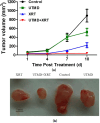Using ultrasound-targeted microbubble destruction to enhance radiotherapy of glioblastoma
- PMID: 33547949
- PMCID: PMC8021517
- DOI: 10.1007/s00432-021-03542-5
Using ultrasound-targeted microbubble destruction to enhance radiotherapy of glioblastoma
Abstract
Objective: To investigate the efficacy and mechanism of ultrasound-targeted microbubble destruction (UTMD) combined with radiotherapy (XRT) on glioblastoma.
Methods: The enhanced radiosensitization by UTMD was assessed through colony formation and cell apoptosis in Human glioblastoma cells (U87MG). Subcutaneous transplantation tumors in 24 nude mice implanted with U87MG cells were randomly assigned to 4 different treatment groups (Control, UTMD, XRT, and UTMD + XRT) based on tumor sizes (100-300 mm3). Tumor growth was observed for 10 days after treatment, and then histopathology stains (HE, CD34, and γH2AX) were applied to the tumor samples. A TUNEL staining experiment was applied to detect the apoptosis rate of mice tumor samples. Meanwhile, tissue proteins were extracted from animal specimens, and the expressions of dsDNA break repair-related proteins from animal specimens were examined by the western blot.
Results: When the radiotherapy dose was 4 Gy, the colony formation rate of U87MG cells in the UTMD + XRT group was 32 ± 8%, lower than the XRT group (54 ± 14%, p < 0.01). The early apoptotic rate of the UTMD + XRT group was 21.1 ± 3% at 48 h, higher than that of the XRT group (15.2 ± 4%). The tumor growth curve indicated that the tumor growth was inhibited in the UTMD + XRT group compared with other groups during 10 days of observation. In TUNEL experiment, the apoptotic cells of the UTMD + XRT group were higher than that of the XRT group (p < 0.05). The UTMD + XRT group had the lowest MVD value, but was not significantly different from other groups (p > 0.05). In addition, γH2AX increased due to the addition of UTMD to radiotherapy compared to XRT in immunohistochemistry (p < 0.05).
Conclusions: Our study clearly demonstrated the enhanced destructive effect of UTMD combined with 4 Gy radiotherapy on glioblastoma. This could be partly achieved by the increased ability of DNA damage of tumor cells.
Keywords: Glioblastoma; Microbubbles; Radiation therapy; Ultrasound; Ultrasound therapy.
Conflict of interest statement
The authors declare no conflict of interest.
Figures





References
MeSH terms
Grants and funding
LinkOut - more resources
Full Text Sources
Other Literature Sources

